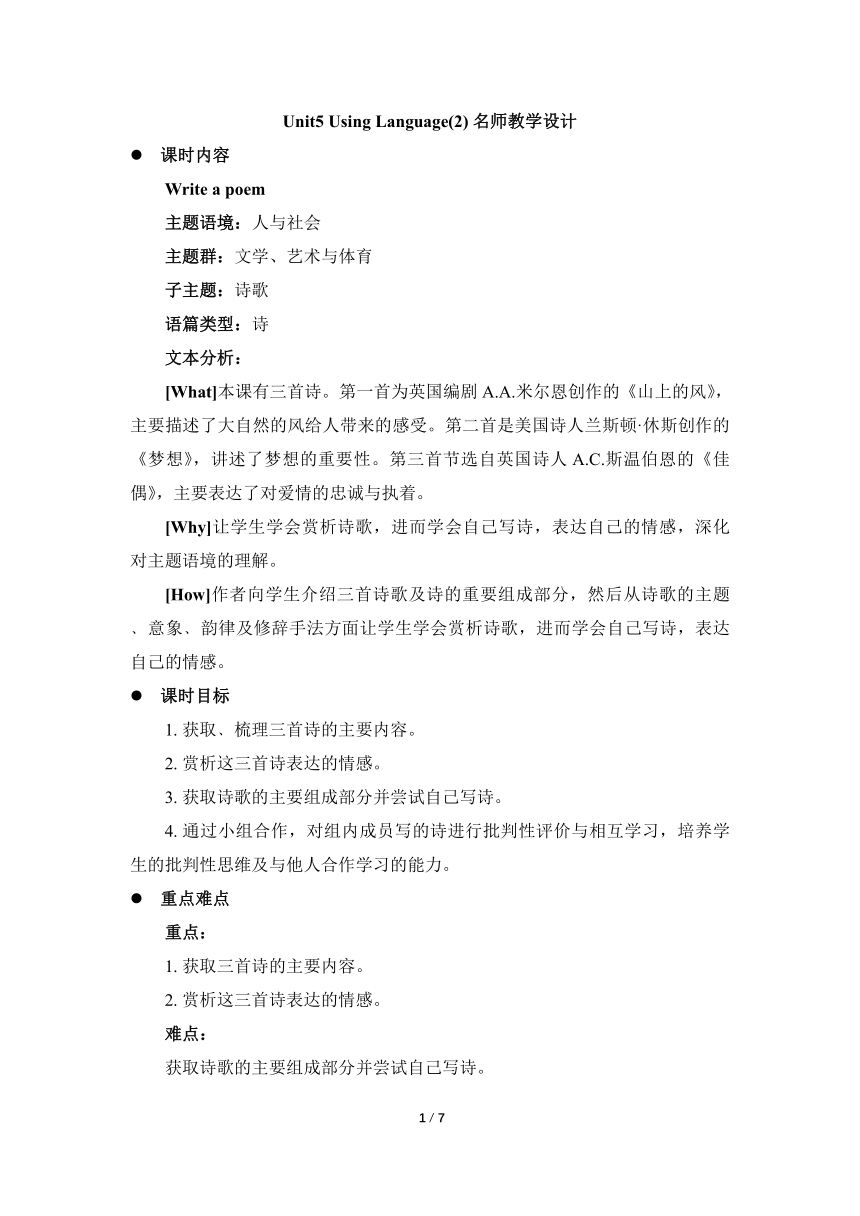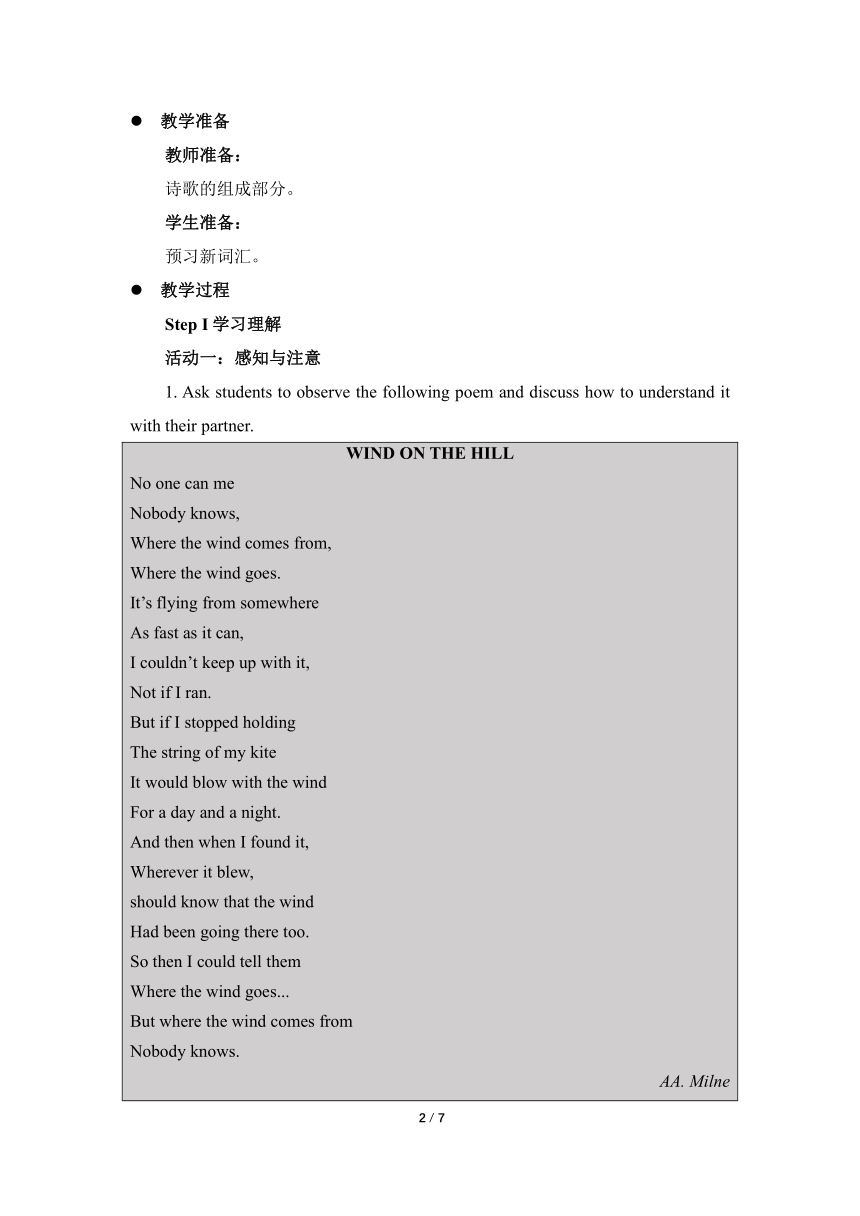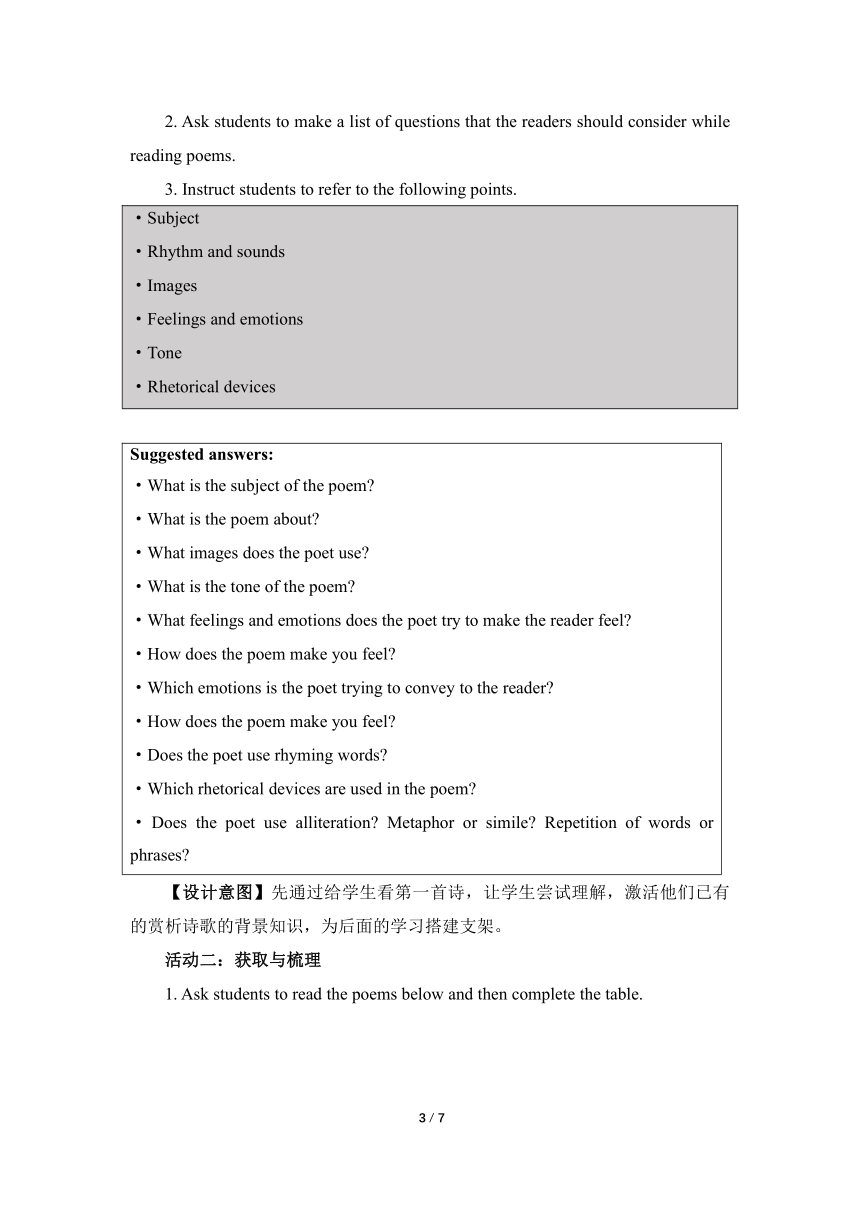人教版(2019)选择性必修第三册 Unit5 Poems Using Language(2) 名师教学设计
文档属性
| 名称 | 人教版(2019)选择性必修第三册 Unit5 Poems Using Language(2) 名师教学设计 |

|
|
| 格式 | docx | ||
| 文件大小 | 1002.1KB | ||
| 资源类型 | 教案 | ||
| 版本资源 | 人教版(2019) | ||
| 科目 | 英语 | ||
| 更新时间 | 2023-03-13 22:36:56 | ||
图片预览



文档简介
Unit5 Using Language(2) 名师教学设计
课时内容
Write a poem
主题语境:人与社会
主题群:文学、艺术与体育
子主题:诗歌
语篇类型:诗
文本分析:
[What]本课有三首诗。第一首为英国编剧A.A.米尔恩创作的《山上的风》,主要描述了大自然的风给人带来的感受。第二首是美国诗人兰斯顿·休斯创作的《梦想》,讲述了梦想的重要性。第三首节选自英国诗人A.C.斯温伯恩的《佳偶》,主要表达了对爱情的忠诚与执着。
[Why]让学生学会赏析诗歌,进而学会自己写诗,表达自己的情感,深化对主题语境的理解。
[How]作者向学生介绍三首诗歌及诗的重要组成部分,然后从诗歌的主题﹑意象﹑韵律及修辞手法方面让学生学会赏析诗歌,进而学会自己写诗,表达自己的情感。
课时目标
1. 获取﹑梳理三首诗的主要内容。
2. 赏析这三首诗表达的情感。
3. 获取诗歌的主要组成部分并尝试自己写诗。
4. 通过小组合作,对组内成员写的诗进行批判性评价与相互学习,培养学生的批判性思维及与他人合作学习的能力。
重点难点
重点:
1. 获取三首诗的主要内容。
2. 赏析这三首诗表达的情感。
难点:
获取诗歌的主要组成部分并尝试自己写诗。
教学准备
教师准备:
诗歌的组成部分。
学生准备:
预习新词汇。
教学过程
Step I学习理解
活动一:感知与注意
1. Ask students to observe the following poem and discuss how to understand it with their partner.
WIND ON THE HILL No one can me Nobody knows, Where the wind comes from, Where the wind goes. It’s flying from somewhere As fast as it can, I couldn’t keep up with it, Not if I ran. But if I stopped holding The string of my kite It would blow with the wind For a day and a night. And then when I found it, Wherever it blew, should know that the wind Had been going there too. So then I could tell them Where the wind goes... But where the wind comes from Nobody knows. AA. Milne
2. Ask students to make a list of questions that the readers should consider while reading poems.
3. Instruct students to refer to the following points.
·Subject ·Rhythm and sounds ·Images ·Feelings and emotions ·Tone ·Rhetorical devices
Suggested answers: ·What is the subject of the poem ·What is the poem about ·What images does the poet use ·What is the tone of the poem ·What feelings and emotions does the poet try to make the reader feel ·How does the poem make you feel ·Which emotions is the poet trying to convey to the reader ·How does the poem make you feel ·Does the poet use rhyming words ·Which rhetorical devices are used in the poem ·Does the poet use alliteration Metaphor or simile Repetition of words or phrases
【设计意图】先通过给学生看第一首诗,让学生尝试理解,激活他们已有的赏析诗歌的背景知识,为后面的学习搭建支架。
活动二:获取与梳理
1. Ask students to read the poems below and then complete the table.
Wind on the Hill Dream A match
Subject
Images
Rhyming words
Rhetorical device
Suggested answers:
Wind on the Hill Dream A match
Subject the wind the wind the wind
Images kite, person broken-winged bird, barren field frozen with snow rose, leaf, fields
Rhyming words knows/ goes can/ ran kite/night blew/ too goes/ knows die/ fly go/ snow together/ weather closes/ is grief/ leaf
Rhetorical device repetition alliteration repetition metaphor repetition metaphor, simile
2. Choose and write.
(1) Ask students to choose one of the poems and write a short essay about it.
(2) Instruct students to observe the essay example below.
The poem Dream by Langston Hughes is very short with only 8 lines. When I read the poem aloud I can hear that the ends of the second and fourth sentences rhyme— “die” and “fly”. The last word from the sixth and eighth sentences also rhyme— “go” and “snow”. These rhyming words sound nice and make the poem pleasing to read. When I close my eyes, I can see different images from the poem. For example, I can see two hands being held. I can see a bird flying in the sky. I can see a field and I can imagine what it looks like with lots of snow. I start to feel cold when I read these lines! I learnt a new phrase, “hold fast”, which means to hold onto something. “Barren” is also a new word to me, which means empty. I think the poet is giving us advice. He wants us to keep dreaming, because life is much better when we dream and have something to look forward to.
【设计意图】通过获取诗的主题、意象﹑韵律及修辞手法,帮助学生理解诗以及了解诗的写作要素,为后面的写作作铺垫。
Step II 应用实践
活动三:内化与应用
Write a poem.
(1) Learning strategy.
Go through the writing steps with students and if necessary, make some explanation.
·Start with the theme first. Ask yourself, “What message do I want to give to the reader What is important to me ”
·Next, think about the words and phrases you would like to use. Make a list of words related to your theme.
·Then check how well your details paint a picture in your head. Now write the poem. Read it aloud and listen to how it sounds.
·Finally, give it a title. Now your poem is ready!
(2) Brainstorm.
Ask students to work in groups and think of a theme by the questions “What message do I want to give to the reader What is important to me ”
(3) Have students think about the words and phrases they would like to use and make a list of words related to their theme.
(4) Have students write the poem.
(5) Have students read the poem aloud and listen to how it sounds.
(6) Have students give the poem a title.
【设计意图】本活动为写作实践。首先让学生获取写诗的主要步骤;然后,引导学生讨论写作内容并按照步骤写作,降低写作难度,增强写作的信心。
Step Ⅲ 迁移创新
活动四:批判与评价
1. Ask students to work in groups and take turns to read aloud their poems and then have a discussion on what they think they mean. Let students give their personal opinion or advice based on what they have learnt from this unit.
2. Inspire students to read aloud their poems to the class.
【设计意图】通过小组评价、探讨等方式,加深对主题意义的理解和批判思维及多元思维的培养,实现深度学习。
板书设计
Unit 5 Poems Period V Using Language (2) Ⅰ. 学习理解 活动一:感知与注意 活动二:获取与梳理 1. Read and complete. 2. Choose and write. Ⅱ. 应用实践 活动三:内化与应用 Write a poem. Ⅲ. 迁移创新 活动四:批判与评价
2 / 2
课时内容
Write a poem
主题语境:人与社会
主题群:文学、艺术与体育
子主题:诗歌
语篇类型:诗
文本分析:
[What]本课有三首诗。第一首为英国编剧A.A.米尔恩创作的《山上的风》,主要描述了大自然的风给人带来的感受。第二首是美国诗人兰斯顿·休斯创作的《梦想》,讲述了梦想的重要性。第三首节选自英国诗人A.C.斯温伯恩的《佳偶》,主要表达了对爱情的忠诚与执着。
[Why]让学生学会赏析诗歌,进而学会自己写诗,表达自己的情感,深化对主题语境的理解。
[How]作者向学生介绍三首诗歌及诗的重要组成部分,然后从诗歌的主题﹑意象﹑韵律及修辞手法方面让学生学会赏析诗歌,进而学会自己写诗,表达自己的情感。
课时目标
1. 获取﹑梳理三首诗的主要内容。
2. 赏析这三首诗表达的情感。
3. 获取诗歌的主要组成部分并尝试自己写诗。
4. 通过小组合作,对组内成员写的诗进行批判性评价与相互学习,培养学生的批判性思维及与他人合作学习的能力。
重点难点
重点:
1. 获取三首诗的主要内容。
2. 赏析这三首诗表达的情感。
难点:
获取诗歌的主要组成部分并尝试自己写诗。
教学准备
教师准备:
诗歌的组成部分。
学生准备:
预习新词汇。
教学过程
Step I学习理解
活动一:感知与注意
1. Ask students to observe the following poem and discuss how to understand it with their partner.
WIND ON THE HILL No one can me Nobody knows, Where the wind comes from, Where the wind goes. It’s flying from somewhere As fast as it can, I couldn’t keep up with it, Not if I ran. But if I stopped holding The string of my kite It would blow with the wind For a day and a night. And then when I found it, Wherever it blew, should know that the wind Had been going there too. So then I could tell them Where the wind goes... But where the wind comes from Nobody knows. AA. Milne
2. Ask students to make a list of questions that the readers should consider while reading poems.
3. Instruct students to refer to the following points.
·Subject ·Rhythm and sounds ·Images ·Feelings and emotions ·Tone ·Rhetorical devices
Suggested answers: ·What is the subject of the poem ·What is the poem about ·What images does the poet use ·What is the tone of the poem ·What feelings and emotions does the poet try to make the reader feel ·How does the poem make you feel ·Which emotions is the poet trying to convey to the reader ·How does the poem make you feel ·Does the poet use rhyming words ·Which rhetorical devices are used in the poem ·Does the poet use alliteration Metaphor or simile Repetition of words or phrases
【设计意图】先通过给学生看第一首诗,让学生尝试理解,激活他们已有的赏析诗歌的背景知识,为后面的学习搭建支架。
活动二:获取与梳理
1. Ask students to read the poems below and then complete the table.
Wind on the Hill Dream A match
Subject
Images
Rhyming words
Rhetorical device
Suggested answers:
Wind on the Hill Dream A match
Subject the wind the wind the wind
Images kite, person broken-winged bird, barren field frozen with snow rose, leaf, fields
Rhyming words knows/ goes can/ ran kite/night blew/ too goes/ knows die/ fly go/ snow together/ weather closes/ is grief/ leaf
Rhetorical device repetition alliteration repetition metaphor repetition metaphor, simile
2. Choose and write.
(1) Ask students to choose one of the poems and write a short essay about it.
(2) Instruct students to observe the essay example below.
The poem Dream by Langston Hughes is very short with only 8 lines. When I read the poem aloud I can hear that the ends of the second and fourth sentences rhyme— “die” and “fly”. The last word from the sixth and eighth sentences also rhyme— “go” and “snow”. These rhyming words sound nice and make the poem pleasing to read. When I close my eyes, I can see different images from the poem. For example, I can see two hands being held. I can see a bird flying in the sky. I can see a field and I can imagine what it looks like with lots of snow. I start to feel cold when I read these lines! I learnt a new phrase, “hold fast”, which means to hold onto something. “Barren” is also a new word to me, which means empty. I think the poet is giving us advice. He wants us to keep dreaming, because life is much better when we dream and have something to look forward to.
【设计意图】通过获取诗的主题、意象﹑韵律及修辞手法,帮助学生理解诗以及了解诗的写作要素,为后面的写作作铺垫。
Step II 应用实践
活动三:内化与应用
Write a poem.
(1) Learning strategy.
Go through the writing steps with students and if necessary, make some explanation.
·Start with the theme first. Ask yourself, “What message do I want to give to the reader What is important to me ”
·Next, think about the words and phrases you would like to use. Make a list of words related to your theme.
·Then check how well your details paint a picture in your head. Now write the poem. Read it aloud and listen to how it sounds.
·Finally, give it a title. Now your poem is ready!
(2) Brainstorm.
Ask students to work in groups and think of a theme by the questions “What message do I want to give to the reader What is important to me ”
(3) Have students think about the words and phrases they would like to use and make a list of words related to their theme.
(4) Have students write the poem.
(5) Have students read the poem aloud and listen to how it sounds.
(6) Have students give the poem a title.
【设计意图】本活动为写作实践。首先让学生获取写诗的主要步骤;然后,引导学生讨论写作内容并按照步骤写作,降低写作难度,增强写作的信心。
Step Ⅲ 迁移创新
活动四:批判与评价
1. Ask students to work in groups and take turns to read aloud their poems and then have a discussion on what they think they mean. Let students give their personal opinion or advice based on what they have learnt from this unit.
2. Inspire students to read aloud their poems to the class.
【设计意图】通过小组评价、探讨等方式,加深对主题意义的理解和批判思维及多元思维的培养,实现深度学习。
板书设计
Unit 5 Poems Period V Using Language (2) Ⅰ. 学习理解 活动一:感知与注意 活动二:获取与梳理 1. Read and complete. 2. Choose and write. Ⅱ. 应用实践 活动三:内化与应用 Write a poem. Ⅲ. 迁移创新 活动四:批判与评价
2 / 2
